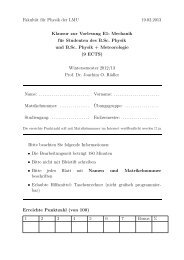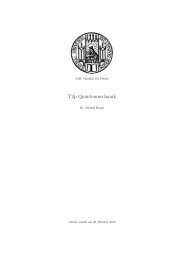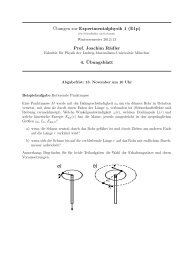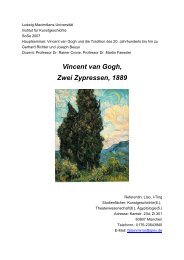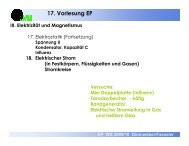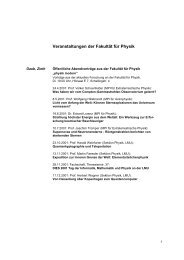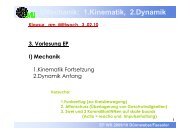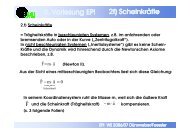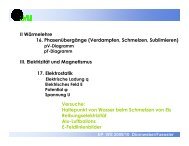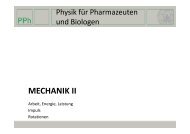Ultrapure, high mobility organic photoconductors
Ultrapure, high mobility organic photoconductors
Ultrapure, high mobility organic photoconductors
You also want an ePaper? Increase the reach of your titles
YUMPU automatically turns print PDFs into web optimized ePapers that Google loves.
168 W. Warta et al.<br />
100<br />
10<br />
1r--<br />
--0 0 0 O0 O<br />
I I I I I IIII ' I ' I '1'1<br />
9 ele~<br />
9 78<br />
+<br />
+++ + 9<br />
+<br />
~ o o + Ella<br />
o -~<br />
e 9<br />
9 E = 6 kV/cm<br />
+ E =20 kV/cm<br />
o E =60 kV/cm<br />
--L--log I I I<br />
10<br />
o<br />
+<br />
o<br />
o+<br />
+ _<br />
+<br />
++<br />
+<br />
++<br />
\ ++<br />
%<br />
\<br />
I I IIII , I , I<br />
50 200<br />
TCK]<br />
Fig. 7. Electron mobilities in perylene for the electric field E<br />
parallel to the crystallographic a direction for different field<br />
strengths (marked by different symbols) between 6 and 60 kV/cm.<br />
The crystal slice had a thickness of 252(3)Ixm<br />
> 1,5<br />
1,0<br />
0,5 ~ ."<br />
. , I , I<br />
10 20<br />
o<br />
n o 84<br />
o<br />
o<br />
Q<br />
I I<br />
@<br />
@<br />
o<br />
o<br />
o<br />
o<br />
I<br />
A 27K<br />
~ o 35K<br />
o<br />
§ 50K<br />
9 9 7OK<br />
9 ~ 100K<br />
I , I , I ~ I ,<br />
30 t.0 50 60<br />
E [kV/cm]<br />
Fig. 8. Electric field dependence of the electron drift velocities in<br />
perylene at 5 temperatures for Ella<br />
maximum at somewhat <strong>high</strong>er temperature and a<br />
more pronounced relative decrease below the max-<br />
imum. In a crystal slice of the less purified material (cut<br />
in an oblique crystallographic orientation) shallow<br />
trap-limited electron mobilities were followed down<br />
to 14 K (Fig. 9) in order to be able to try a fit by the<br />
Hoesterey-Letson multiple shallow trapping formula<br />
[3] for obtaining the trap parameters. In this model the<br />
carrier mobilities fall with decreasing temperature<br />
because the carriers stay for increasingly longer time<br />
intervals in the trap states before they are thermally<br />
reactivated to move freely in the band for a short while.<br />
><br />
E<br />
,'4,<br />
89<br />
100 -<br />
T<br />
10<br />
o<br />
-- o I<br />
- +:<br />
i<br />
v,<br />
1 - p<br />
o, o'<br />
-t-tog<br />
10<br />
i<br />
I .'. I I I I III<br />
," ~ ~ n=-1,87<br />
/z~ ~<br />
it o<br />
1<br />
t<br />
r<br />
+<br />
/~ ~<br />
~<br />
k o<br />
r'<br />
++<br />
+<br />
\ %<br />
E = 8 kV/cm + %<br />
I ' I 'l'l<br />
o E= llkV/cm + ++<br />
', E= 13kV/cm \<br />
+E= 16kV/cm \ -<br />
\<br />
o E= 22kV/cm<br />
o E= 27kV/cm<br />
I I I I IIIII , I , I,I,I<br />
50 200<br />
~--- TEK]<br />
Fig. 9. Electron <strong>mobility</strong> as a function of temperature in perylene<br />
in an oblique crystallographic direction [~ E, a =45(1) ~ g E, b<br />
=66(1) ~ ~E,c*=55(1)~ sample thickness was 370(10)pm].<br />
The broken line is a fit with the Hoesterey-Letson type shallow<br />
trapping model [3] with the parameters trap depth, Etr<br />
= 17.5 meV, and trap concentration, Ntr/N b = 5 x 10 -4 mol/mol<br />
These trap-influenced "effective mobilities" #elf are<br />
governed by the underlying microscopic (lattice) mo-<br />
bility #o(T), the density of trap states Ntr, relative to<br />
band states Nb, and a Boltzmann factor with the trap<br />
depth Etr:<br />
#af(T) = #o(T) [1 + (Nt~/Nb) exp (Et~/kT)] -1 (2)<br />
Before we apply this formula to interpret the results of<br />
Fig. 9, we wish to emphasize that between 40 and<br />
300 K the perylene mobilites were reproducible within<br />
experimental error between crystals fro m different<br />
batches, which [besides the fact that the temperature<br />
dependence was found to obey a #o oc T n (n < 0) law]<br />
supports their interpretation as true lattice mobilities.<br />
This good reproducibility is also demonstrated by the<br />
fact that it was possible to closely fit the experimental<br />
data of 15 series of measurements in 10 different<br />
crystallographic directions by a (temperature-<br />
dependent) second rank tensor [17].<br />
We find for the less purified crystal, by fitting [19] the<br />
Hoesterey-Letson equation (2) to the experimental<br />
points (Fig. 9) between 20 and 14 K, that there is only a<br />
very shallow trap left with a trap activation energy of<br />
Err = 17.5 meV and a concentration Ntr/N b<br />
= 5 x 10-4 mol/mol. A trap with these parameters can<br />
only exert notable influence on the (macroscopic)




